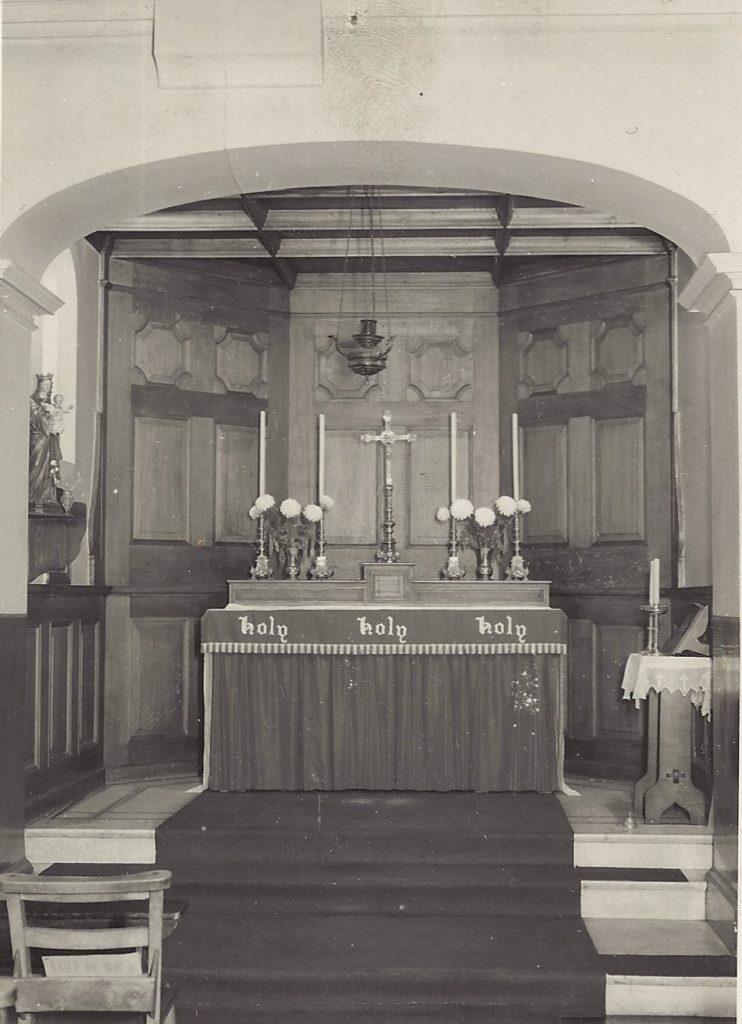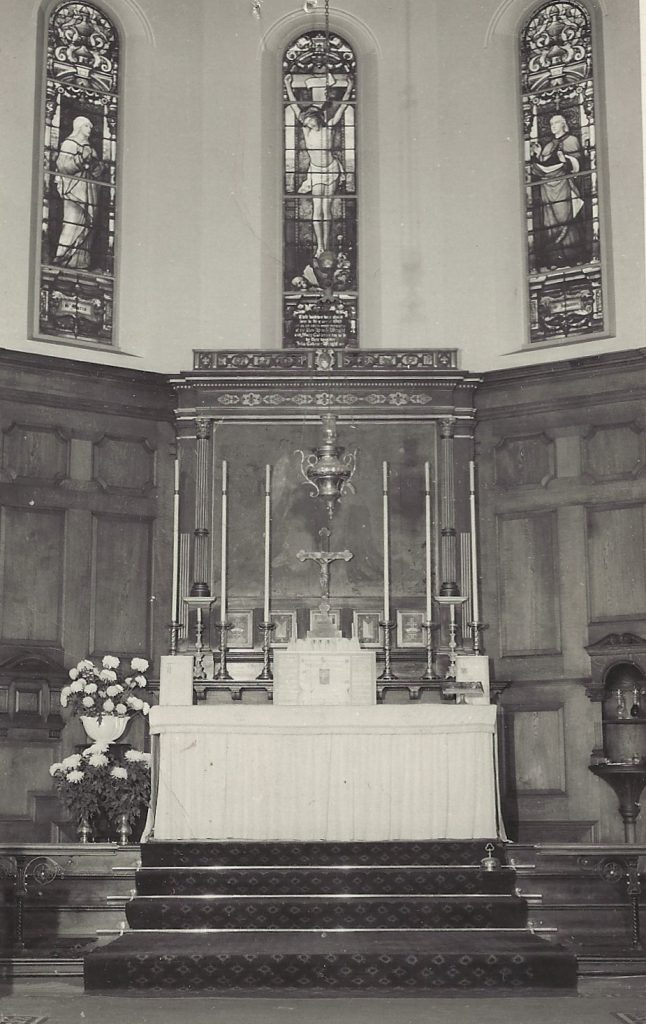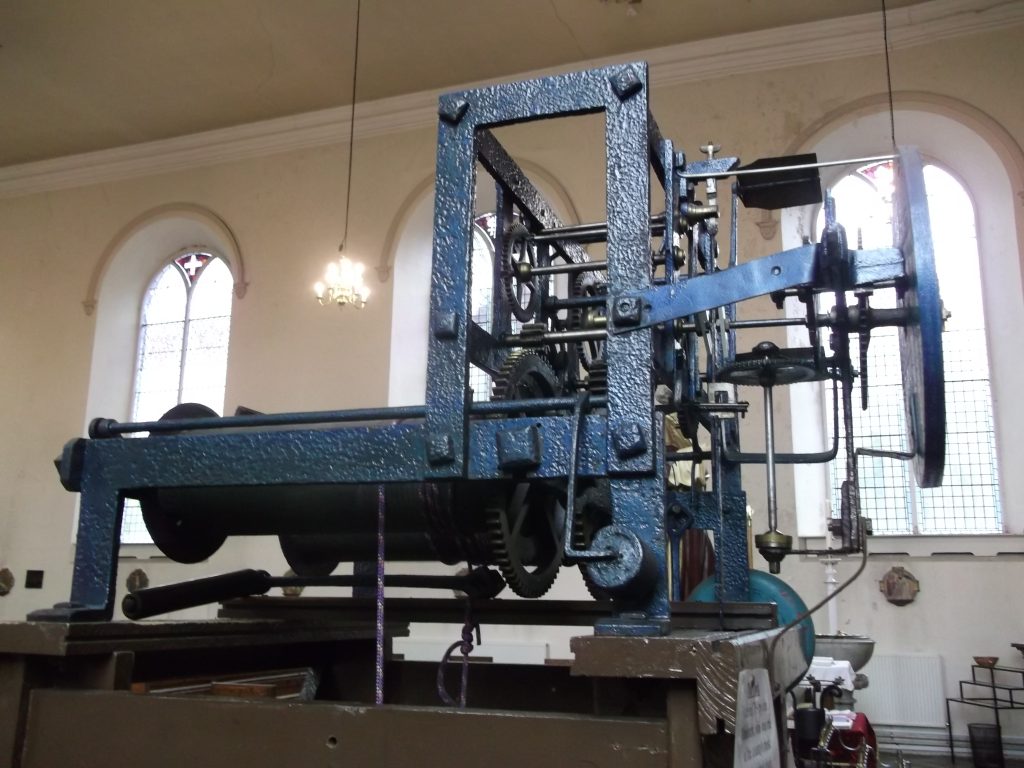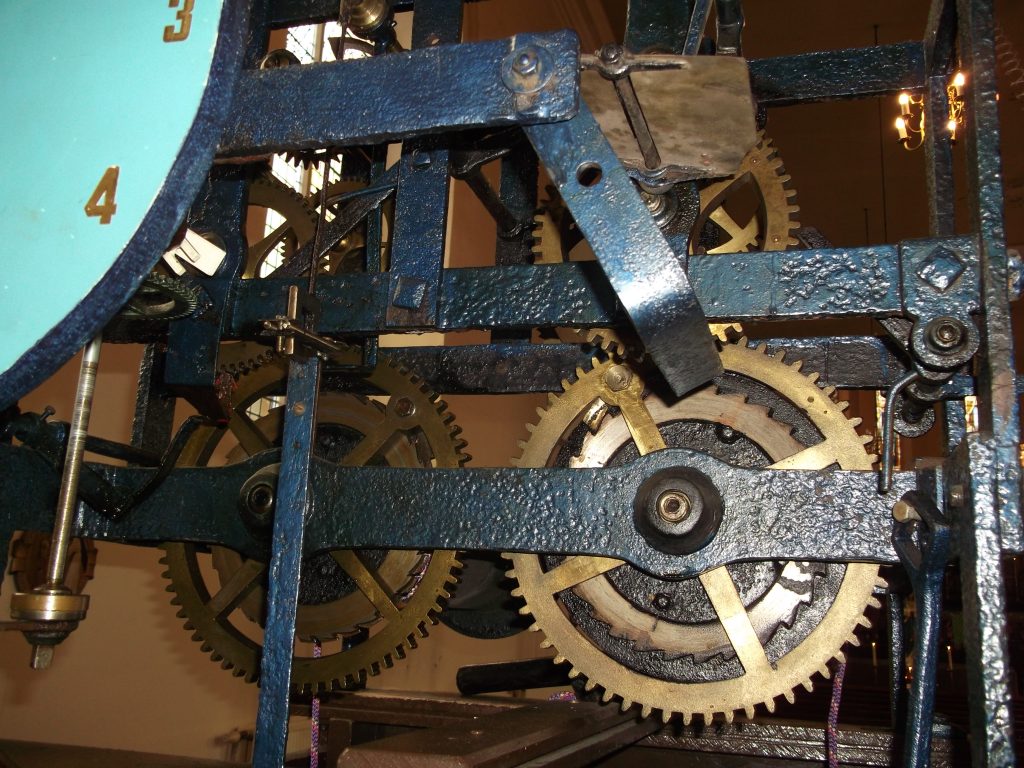
Saint Peters Church is a Georgian church built in 1768 during the reign of George III, at the sole cost of William Wright of Mottram Hall, Mottram St Andrew, near Prestbury, who owned extensive properties in Offerton and had a town house on Lord Street. The architect of the present Mottram Hall is believed to have designed the church. The foundation stone bears the motto “To the Glory of God and for the Good of Mankind”, but its whereabouts is not known. A fine Georgian vicarage was erected to the south of the church but was demolished in 1956.
The church was consecrated on 31st May 1768 by Bishop Edmund Keene of Chester.
“On Monday 30th May the Right Reverend the Lord Bishop of Chester arrived at Stockport on his return to his diocese, from his attendance in parliament. On the next day his Lordship consecrated the very handsome commodious chapel erected in that town at the sole expense of William Wright Esq. of Mottram St Andrew and amply endowed by the exemplary munificence of that worthy founder and patron.”
Manchester Mercury 1768
It was built to cater for the rapidly increasing number of inhabitants of industrial Stockport but was situated in a pleasant position at the edge of the town as the view of about 1780 shows. Described in the 1768 St Peters Chapel Act as “lying near or adjoining to the said town of Stockport”. Even by 1824 the church still stood amongst fields and gardens, although the new Wellington Road, and Wellington Bridge over the River Mersey were soon to change that.
St Peters can claim to be the oldest complete church building in the town, the only ecclesiastical architecture that is older is the beautiful medieval chancel of St. Mary’s in the market place, its nave and tower were entirely rebuilt to new designs in 1813. The old tower had become unsafe due, it was said, to the continuous ringing of the bells in celebration of Nelson’s victory at the Battle of Trafalgar in 1805!
“To the Glory of God and for the Good of Mankind”
The church of 1768 was not much different from the building as you see it today, except that it ended at the present chancel wall with a small apse at the east end, An altar table was situated in the apse, with a large “three decker” pulpit directly in front of it.
The 1851 Large Scale plan of Stockport shows this clearly, together with the position of the pulpit. The dotted line shows the front of the gallery which was on three sides at that time. If you look at the block floor under the front pews you will find a line of blocks which indicate the extent of the old chancel area. On 6th March 1782 a faculty was granted for the construction of a “western gallery” to hold pews and organ. The present windows are of late Victorian coloured glass, but in all probability the original design is the one that survives in the tower window, and which is typical of the style of many Eighteenth century church windows with the neo Gothic influence just starting to manifest itself.
In 1838 the church was closed for 10 Sundays during the erection of side galleries “for the admission of the poor”. This increased the church’s seating capacity to 600. These were taken down in 1888 when the church was enlarged with the present chancel and sanctuary. The west gallery was retained. The old pulpit was removed, and new seats were introduced replacing the high backed pews.
The population of Stockport had increased to 33,356 by 1822 but was only served by two C. of E. churches, St. Mary’s and St. Peters, hence the building of St. Thomas’ on Hillgate in 1825. It is interesting to reflect that there were only 58 communicants on Easter Day 1826 (the earliest communicant figure recorded) at S. Peters, despite the large population of the town.
Schools
The next important step at St. Peters was the opening of the St Peters National School in 1844 built to the north of the churchyard. The school was designed by Mr Plant, architect of Tiviot Dale Chapel and opened initially as a Sunday School. About ten years later it opened also as a Day School for infants. After it was closed for a short time as a Day School, it was again opened as a Mixed School under Government Inspection in 1861. The school continued to be carried on in this building until September 1871, when it was closed for alterations and enlargement. In 1895 an additional school building was opened to the west of the church, this closed in 1958, the old school having been closed in 1953. Both have since been demolished.
In 1861, St Thomas’ Parish was formed out of the Parish of St Mary’s, and St Peters was made an “Ecclesiastical District” with 4,455 inhabitants. It only became a fully fledged Parish and Parish Church in 1968, exactly 200 years after its consecration, with the Pastoral Measure which converted all “Ecclesiastical Districts” into parishes.
Riot!
Religious rivalry was intense in the 19th century, and Stockport had numerous Nonconformist Chapels, as well as its famous Sunday School, believed to be the largest in the world. The immigration of Irish people fleeing the potato famine, and settling in the developing Northern industrial towns exacerbated this rivalry, and in 1852, on St Peters Day, 29th June, a riot started in St. Peters Square. Windows in St Peters Schools were broken, the homes of Irish tenants living in Rock Row were sacked, and the Roman Catholic Chapel in Edgeley was broken in to with all of the vestments being destroyed. The priest’s books were burnt in his garden, 100 people were seriously injured, one killed and 62 arrested. At the time St. Peter’s was very “Protestant” and it is said that the incumbent helped to incite the antagonists, which would explain why the school was damaged.
The Oxford Movement
As the 19th century progressed the Church of England was being revitalised by the “Oxford Movement” which emphasised the pre-reformation traditions and practices of the church, and the need for colour, light and drama in worship, with the reintroduction of vestments and incense and a real sense of the majesty and the presence of Christ in the Holy Communion.
The actual day this arrived at St. Peters can be identified from the Registers of Services.
With the Induction of the Reverend Edward Reeve on 24th July 1878 there began a diligent keeping of all the Feasts and Saints Days and Holy days, with their eves, including the Eve of Corpus Christi. Many of the renowned Tractarian priests of the day graced the pulpit, including one of those who were subsequently imprisoned for contravening the odious Public Worship Regulation Act of 1874 by wearing Eucharistic vestments, Fr. J. Bell Cox. The drama of the arrival of Fr. Reeve is heightened by the fact that on the Sunday prior to his Induction the Rev’d Hugh Stowell, a renowned Manchester evangelical, preached at both Morning and Evening Prayer.
Font
Clearly this was a fresh start for St Peters and it seems more than just coincidence that the earliest Baptism Register dates from this new incumbency. The first entry being 2nd August 1878. The Baptism Registers of St. Mary’s Parish Church preceding this date have entries that make reference to St. Peters and it appears that Baptisms only started in St. Peters in 1878. The font, a very attractive marble bowl atop a four-columned stem, is in the early English perpendicular style but was probably manufactured at around this time.

Robed Choir
It was at this time, 1878, that a robed and surpliced choir was begun which established a very high reputation and, for the first half of the twentieth century was renowned for the quality of its plainchant. Its demise was brought about primarily by the closure of the church schools, and the consequent loss of a steady supply of boy trebles.
In May 1884 gas lighting was introduced together with three additional windows over the altar. Fr. Reeve had obviously worked hard to develop St Peters and to teach Catholic Faith and Practise. He was described as ” having built up a flourishing church and excellent schools, but was very much an ordinary parish priest, lacking the eloquence of many of his peers”. In 1885 he went as Rector of S. Alban Cheetwood in Manchester.
Chancel Extension
The arrival of Fr. Herbert Bury, later Bishop Bury, saw further great strides forward with the ambitious enlargement of the chancel and sanctuary to provide worthy accommodation for the catholic ceremonial, and choir. By looking at the outside of the building and the Accrington brickwork, you can see the extent of the addition. It was completed in 1888 and was a great enhancement to the building, further enriched by the five beautiful Belgian stained glass windows by Carponnier. He also made the east window of St. Marks Bredbury.
By the end of the nineteenth century the church had four priests and did a tremendous amount of work in helping the poor of the parish.
Canon Barnes
Canon Barnes’ long incumbency, 1908 – 34, is commemorated by the Stations of the Cross, and is still remembered by some of the older members of S. Peters. It saw the great days of the festival processions around the parish, and the addition of the small apse to the Lady Chapel in 1927.
As well as drawing people from Stockport, St. Peters attracted many people from outside because of its distinctive Catholic teaching and practise, and wonderful worship with High Mass every Sunday. A sharp contrast to Morning Prayer with hymns and sermon, which was the main Sunday morning service at most parish churches. Today, the equivalent of a Sung Mass, the Parish Eucharist, is now the norm, fulfilling a key objective of the Tractarians that the service instituted by our Lord himself should be restored as the focus of worship in the English Parish church, as it had been for over 1000 years, until the Reformation.
After 1945
The demolition since the war of virtually all the houses, with their replacement by commercial property, and the consequent closure of S. Peters Schools, brought about strenuous efforts by the ecclesiastical hierarchy to close the Church, but the remaining worshippers resisted successfully and now, although hardly anyone lives in the parish of St. Peters, it has developed a vital new role as a town centre church, whilst retaining the richness of its traditions.
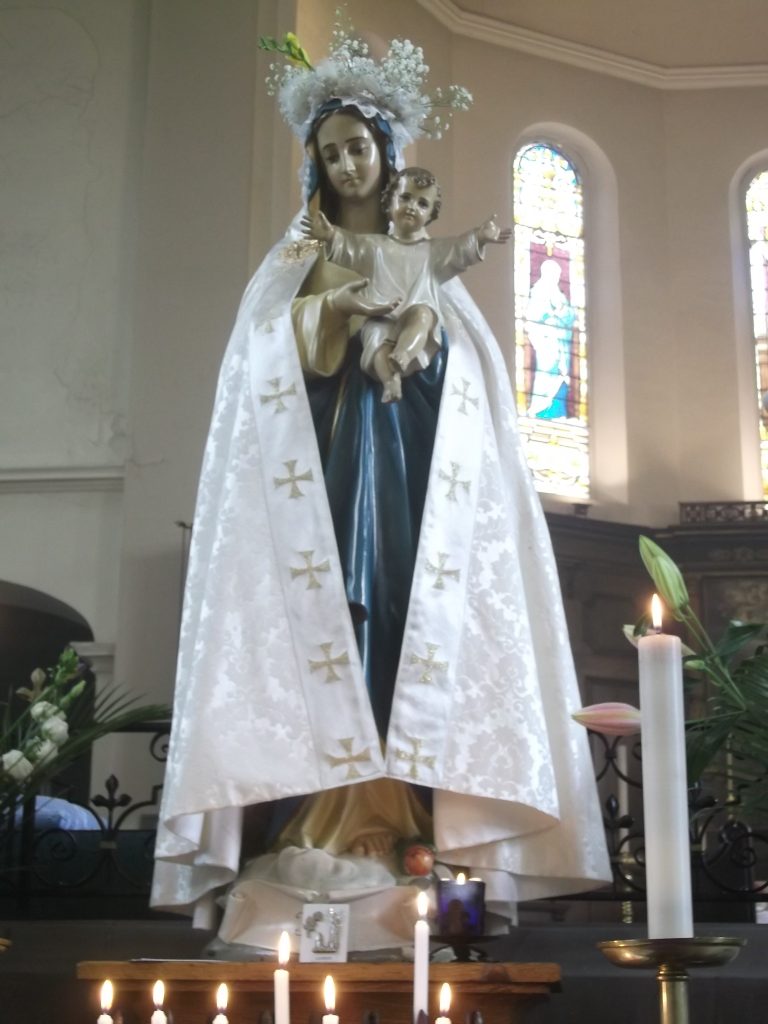
Statue of Our Lady after Crowning 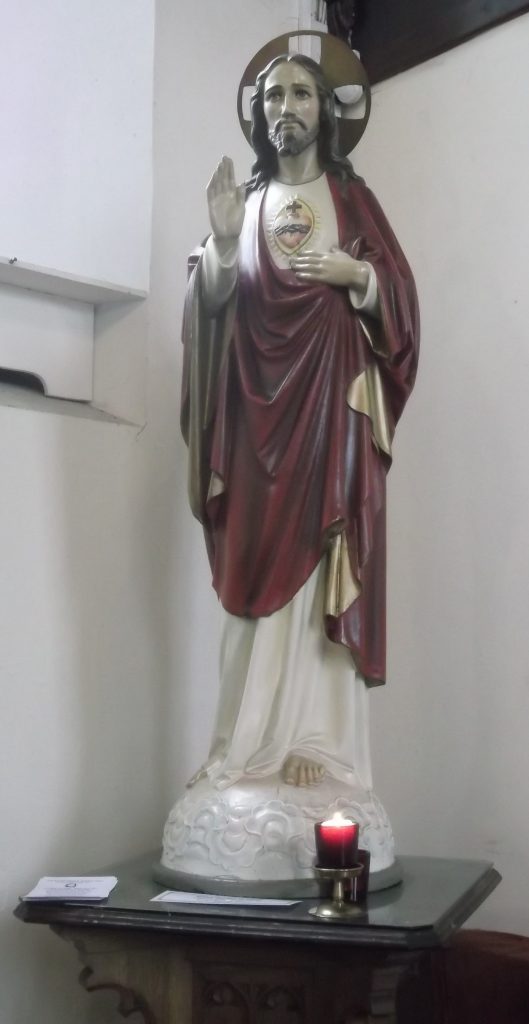
Statue of the Sacred Heart of JesusS 
Statue of St. Peter
Distinctive signs and symbols
The visitor will notice certain features which are not found in many English parish churches, particularly the statues which are of our patron saint, St. Peter, Our Blessed Lady, and the Sacred Heart of Jesus. The practise of asking the saints in heaven to pray for us dates back to St. Paul, and the statues are never intended to be worshipped, but to act as graphic pictures to remind us that the saints are alive in heaven, are with us in our worship, and are constantly offering prayers for the Church on earth. Lighting a candle can signify a special intention and, just as it continues to burn after we have left, so the saints continue to pray to God though Jesus for us.
By the doors there are small bowls, stoups, which contain water that has been blessed. The practise is to dip our fingers and make the sign of the cross, + forehead to chest, shoulder to shoulder, as a reminder of our baptism, wherein the promise was made to confess the faith of Christ crucified, and our sin was washed away. Christians should never be ashamed to make the sign of the cross: ” God forbid that I should glory, save in the cross of the Lord Jesus Christ.” – St. Paul.
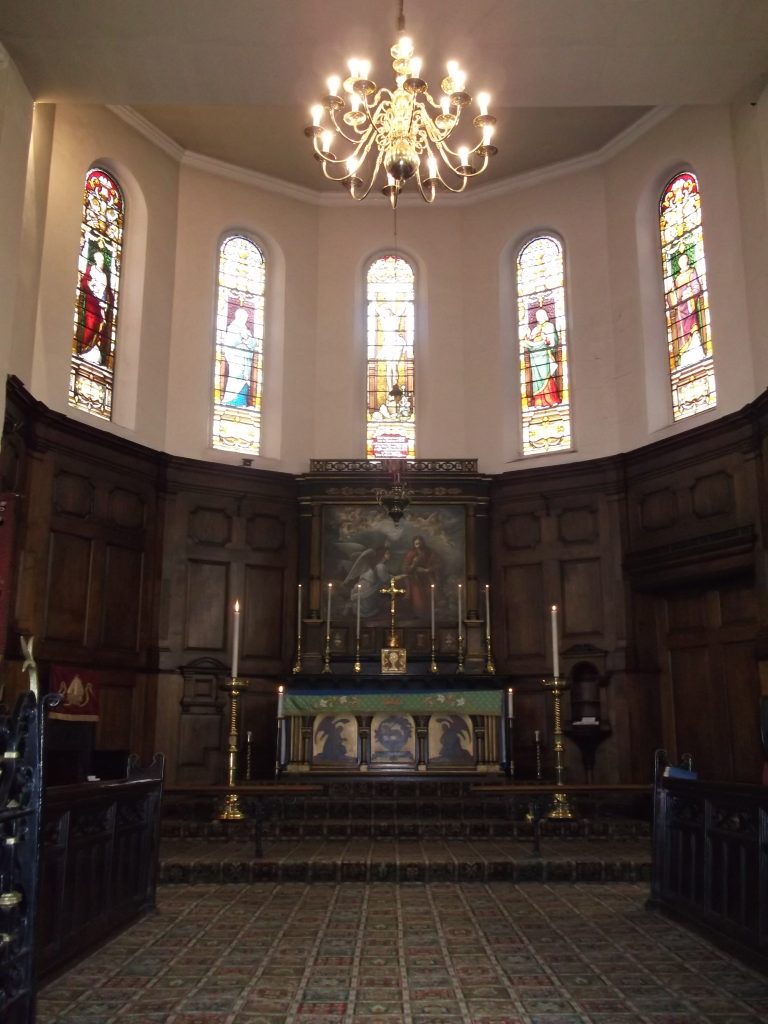
At the east end there used to be seven sanctuary lamps burning; now there are three lights on continuously day and night. The red one is simply to remind us of the presence of God in His holy house. The white, which is next to the Tabernacle, meaning “place of dwelling”, shows that the blessed sacrament of our Lord’s body and blood is reserved there for the sick, (in case someone wishes to have Holy Communion quickly), and for adoration. It is the practise to genuflect before the Blessed Sacrament and visitors are respectfully asked to adhere to this custom. For some obscure reason genuflecting ( literally : bending the knee ) is regarded as not permissible, because it is “high Church” , but it is only obeying S. Paul’s injunction that “at the Name of Jesus , every knee shall bow.”
Anglo Catholics believe that at Mass (the Eucharist) the bread and wine become the Body and Blood of Jesus Christ, and should be venerated accordingly. The Blessed Sacrament is a portion of that consecrated bread, known as the Host. At the Last Supper Jesus didn’t say “this represents my body”, or “this symbolises my body”. He said “This is my body, this is my blood. “This understanding characterises the CATHOLIC FAITH.
The blue light in the Lady Chapel is simply blue traditionally for Our Lady, although this was not always her colour; an interesting contrast is the statue in the Chapel which is painted in her medieval colours.
Modern history
The area under the gallery was enclosed in 1990, as a bold investment exhausting the church’s dwindling reserves. It made room to enlarge the existing Coffee Bar which had been in the old vestry, and to provide essential kitchen and toilet facilities. Subsequently a generous benefaction from Fred Steward, a lifelong member of St peters and former Churchwarden, financed the urgent repair of the chancel ceiling, the dry rot outbreak at the east end, and rewiring, relighting, with Flemish style chandeliers, and redecorating. Everyone agrees that the church has never looked as beautiful as it does now.
St Peters has become a lively centre for meeting and for prayer and private worship during weekdays, and, with its well stocked gift shop, and good food, provides a warm Christian welcome to visitors and tourists, as well as members of the church. The objective is to build upon this witness as a living church in the town, where people know they can pop in and see friends, attend a lunchtime service and have opportunities to grow in their faith. Also, by presenting regular concerts, recitals and special events. To encourage people to come in and enjoy the building, it’s atmosphere and its fine acoustics.
Thankfully, the Coffee Bar and Shop at the west end has not affected the sanctity of the Church, for so many comment upon the peace and the sense of God’s presence that they experience here, as they pray.
High Altar and Altarpiece
The focal point of the church is the High Altar, with the reredos painting of the Agony in the Garden and was given in memory of John Mottershead. It was recently commissioned to replace the original Victorian picture of the same subject by J. H. E. Partington which had been overpainted. It portrays our Lord in the Garden of Gethsemane on the night of his betrayal. “And He knelt down and prayed saying, Father, if Thou be willing, remove this cup from me: nevertheless not my will, but Thine be done. And there appeared an angel from heaven, strengthening him. And being in agony he prayed the more earnestly.” S Luke 22v41-44. The artist, J. Martin Pitts, describes the scene as one in which Heaven and Earth overlap. Contained within the ordinary is the extra-ordinary. Awareness and knowledge of this are the essence of religious experience, and we believe we are never closer to this than when we share together in the Holy Communion.” The theme of the picture is echoed by the church building itself which seeks to provide an atmosphere where we can sense that we are in God’s presence, that earth and heaven come together. Two past masters of religious art inspired the style of the painting, Murillo and Caravaggio.
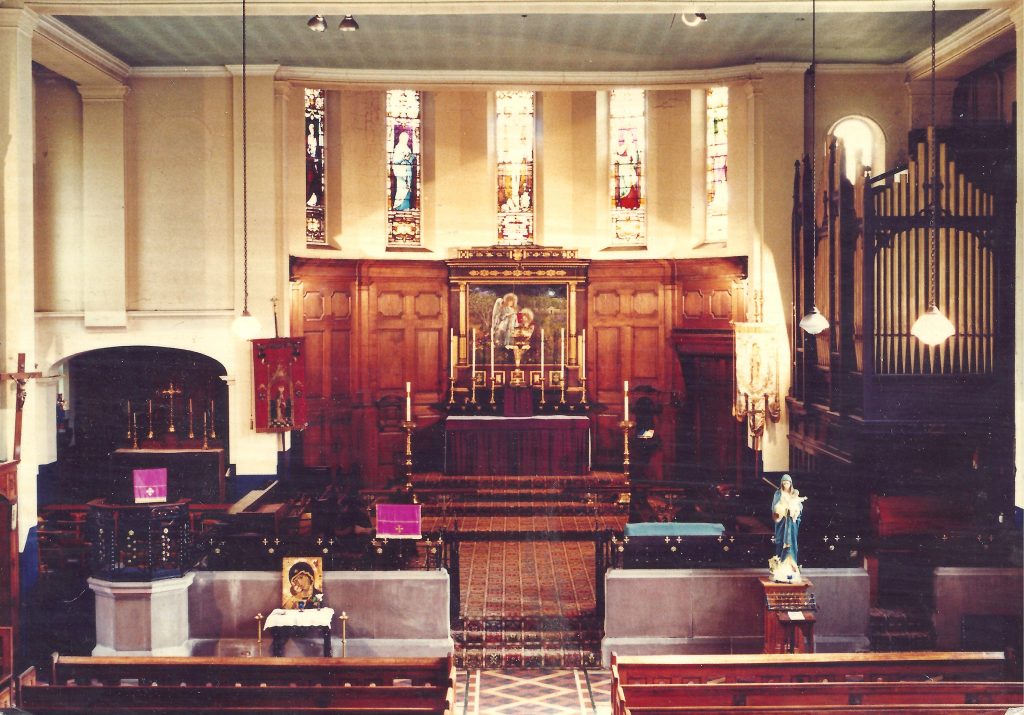
The Organ
The original organ was built on the west gallery in 1788 by the famous Samuel Green “Organ-builder to the King”, and the principal subscriber towards its cost, Mr William Fowden was also the first organist.. In 1875 the organ was rebuilt by Gray and Davison, in the same position, and probably retaining the original case. This case was discarded when the organ was rebuilt on the south side of the chancel as a three manual by Nicholson of Worcester in 1901 with a pneumatic action which has subsequently been the cause of its demise. They retained just five of the original Samuel Green stops namely Great Small Open Diapason, Great Principal, Great Stopped Diapason, Swell Open Diapason and Swell Stopped Diapason. The organ has now been dismantled, revealing the south windows of the chancel, and making space for the replacement organ, a two manual Copeman Hart instrument. The Samuel Green pipes have been included in the rebuilding of an organ at the redundant church of St. Leonard Bridgnorth, Shropshire.
Furnishings and contents
Most of the furnishings are less than a hundred years old, although some are difficult to date accurately, for example the unusual Bishop’s Chair with its carved linenfold back. The alterations and enlargement of 1888 resulted in the replacement of the original Georgian fittings, with new altar, altar rail, pulpit and pews. We also have the altar rail from the partly demolished Christ Church Heaton Norris. The wooden staircase in the tower leading to the gallery is original with a simple banister which at present is mostly obscured by the boiler room.
Pictures
On the south wall of the Chancel there is a large framed embroidered tapestry depicting the Annunciation to Our Lady by the angel Gabriel. It was designed as a frontal for the Lady Chapel Altar but has been framed to protect it. On the reverse is written “To the Glory of God. The work and labour of love of Charlotte Pickering 1937 Stoke Albany Rectory Diocese of Peterborough.”
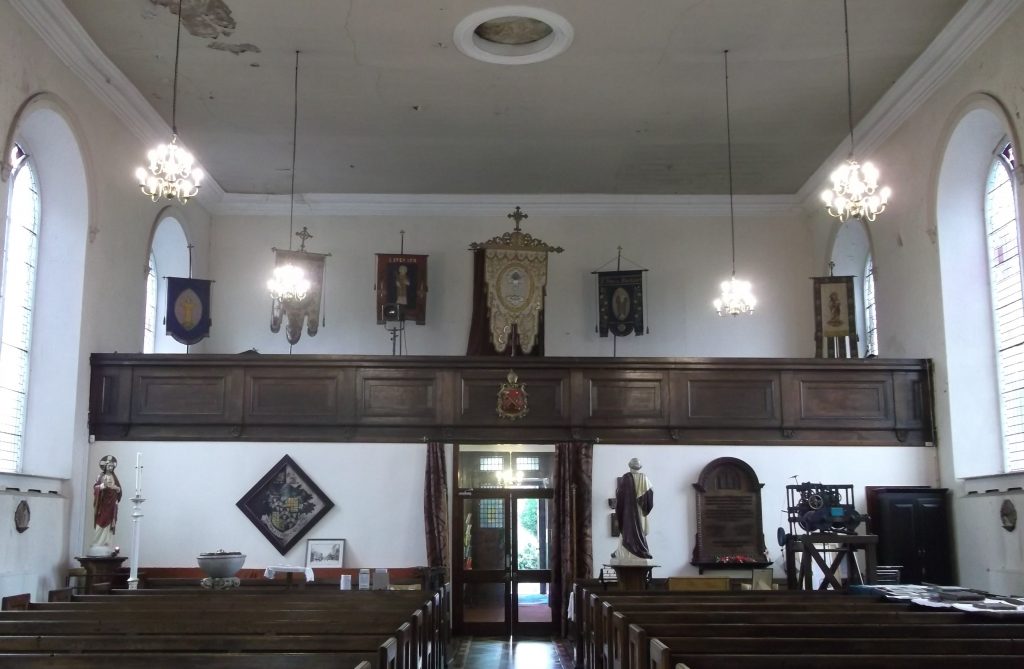
Banners
The gallery displays the marvellous Blessed Sacrament banner, and those of the Communicants Guilds: St Peter (men) Our Lady (women) St Stephen (boys) and St Agnes (girls), together with the MU banner.
The Clock 1768
Made by John Whitehurst, who was one of the country’s most distinguished clockmakers. Well known in the intellectual circles of his day, a member of the Royal Society, he held the position of “Stamper of the Money Weights”
The mechanism is on view in the church and was restored to working order in 1985 after many years of neglect. It is reputed to be the oldest public clock in Greater Manchester and is a fine example of the maker’s work. The design of the dial on the tower is not the original. It is hoped to restore clock and dial and affix a second one facing west which will be visible from the railway viaduct and the A6.
The Bell 1768
This is high up in the belfry and was cast at Rudhall Foundry in Gloucester. It is inscribed: “Prosperity to this town T.R. 1768” and originally rung the hours of the day for the clock. As well as calling the faithful to prayer, it is also used to ring the Angelus. Three threes and a nine at midday , as a reminder of the incarnation of Jesus Christ, true God and true man. Miss Mary Drinkwater, a teacher at St Peters School published this wonderfully descriptive poem in 1922 :
THE ANGELUS
Softly from the belfry
Ringeth the Angelus hour,
Three times the Salutation,
Nine for the closing prayer.
For some it has no message,
Through ignorance or sin.
To others the voice of God is heard
Above life’s bustle and din.
It reminds of the Incarnation
To those who know it well;
And their hearts lift up in thanksgiving
To Him who on earth did dwell.
And a thought of the Holy Mother,
In her obedience sweet,
Bids them bring their own obedience
And offer it at His feet.
The Twentieth Century and beyond has seen a steady decline in churchgoing, and the Victorian era is thought of a as heyday but it is interesting to note from St Peter’s Register that from a high of Easter communicants in 1839 of 123 the figures decline steadily to only 32 in 1867 nearly thirty years later. We do rather better these days. Christmas Communicants over the same period show the same steady fall, going from 155 down to 25, so perhaps it is no wonder that the patron Julia D’Arley Wright, a descendent of the founder William Wright, presented a Tractarian to the living in 1878. She was later to covert to the Roman Church, giving the large 3ft crucifix, which hangs near the pulpit, as a farewell gift to St Peters. The patronage subsequently passed to the Church Union.
Can you help?
If you have any additional information or pictures, especially one which we know was taken just before the alterations to the Chancel in 1888, and which was made available to parishioners. Please let us know through the contact page.


